Machine Guided Construction - Advantages
Presenting a bird's eye view of machine guided construction from a surveyor's perspective, this article highlights the advantages of replacing traditional survey methods with machine guided construction.
Published: 4th September 2010
Author: MachineGuidance.com.au

Introduction
The art of surveying has progressed a long way since its ancient Egyptian origins. Early survey tools involving long sections of rope with markings were replaced with chains, compasses and complex mathematical equations, which in turn were replaced with theodolites and eventually total station instruments. Over time, inventions have appeared that have made a surveyor's job not only easier, but much more accurate.
Today surveyors can utilise GPS satellite technology to determine centimetre accurate positions along with EDM Total Station measurement tools for millimeter accuracy. Additionally, survey software has become more user-friendly and intuitive allowing for efficient and widespread field use, including the integration into construction machines.
Machine guided technologies present enormous advantages for a construction surveyor, along with some significant challenges. This article will concentrate on the advantages of machine guided construction from a surveyor's perspective. More details on some of the more common challenges of this technology can be located here.

Advantages of Machine Control
Pegless Construction
Construction sites and survey pegs have historically gone hand-in-hand. A traditional earthworks operation firstly involves the surveyor building batter rails on both sides of the alignment to define the design edges and batter slopes. Once the bulk material is removed, additional survey pegs are required for the trimming of each alignment. Additional roadway features such as cut benches and drains also require survey pegging.
However, because machine control operators have constant design guidance from within their machines, they no longer require the traditional survey pegs. With design information loaded into the construction machinery, the operator is able to view real-time cut and fill values displayed inside the machine's cab. Operators are able to view both horizontal and vertical data for every millimetre of the jobsite rather than relying on survey stakes and grade-checkers with string lines and tape measures for guidance.
The operator can switch between plan, cross-section or profile views as required. Vertical offsets can be applied to the design for differing pavement levels. A variety of other information can also be viewed as required, such as the cross-slope of a grader's blade or the horizontal distance from an excavator's bucket to the toe of a batter.
The fact that GPS guided plant can operate independently of any survey pegging has significant cost benefits. Less survey pegs means less survey field requirements. The need for grade checkers is eliminated. There is also considerable savings in survey consumables (stakes, ribbon, etc).
Overall, the creation of a pegless construction site eliminating the need for bulk earthworks setout is undoubtedly the biggest advantage of the use of machine control over traditional forms of construction.
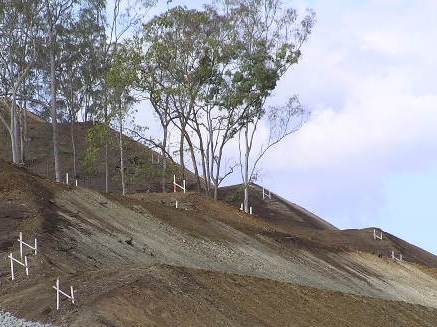
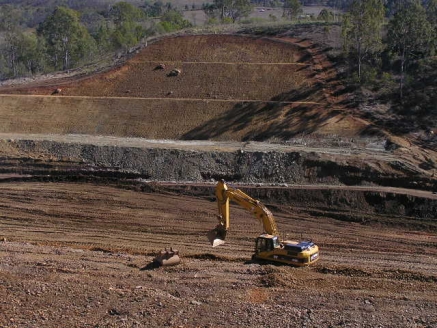

Improved Accuracy
Earthworks is a game of cubic meter volumes and heavy machinery. The challenge of moving earth to tolerances of millimetres is daunting to say the least. For years, mankind has managed this process with rudimentary tools like sticks and strings. This system sometimes works well but is always time consuming.
Errors are common due to leaning and disturbed pegs, slack stringlines, miss-read tape measures and "eying in" information between the pegged cross-sections. Therefore, when a surveyor used to show up to check final results, there was little guarantee that the results would be within tolerance.
Machine control equipment can now eliminate all the old tools from the construction site. With constant design reference for every millimetre of the job, machine guidance enables more accurate construction than traditional survey methods.
The accuracy of the machine control systems ensures grades that are within tolerance every time. Rookie machine control operators are able to use the system to continuously check the constructed results. More experienced operators are able to achieve accuracy on the first pass.
Machine guided construction eliminates the requirement for mid job survey works such as replacing missing and disturbed stake setout. It also results in faster survey quality-assurance checks as there is rarely the need to trim off any high spots. Thus earthworks construction projects using machine guidance experience fewer errors and greater conformance.
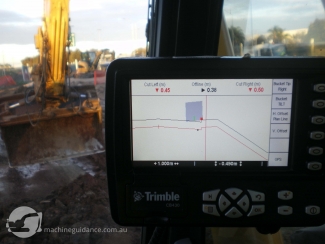
Design Updates
Traditionally, a design change made during the progress of a project results in any survey field setout being inaccurate until the survey crews identify the changes and then became available to re-mark (or completely remove) them. This is obviously not an instantaneous process. Consequently, there is a real risk of an intended design change being missed in the field.
With the use of machine guidance in replacement of survey pegs, the design changes are electronically updated into the system. Design changes can be quickly and easily distributed to the machine for instant use. Similarly, superseded designs can be removed from the machine in the same manner, ensuring that only current information is available in the field.
Thus the timely exercise of surveyors needing to remove and replace setout stakes in order to reflect design model changes can be eliminated using machine guidance technologies.

Unplanned Works
It is a reality of construction that work does not always proceed as planned. Unpredicted delays often result in the need to move earthworks activities at the last moment. Traditionally, this involved waiting for rushed survey setout in the new work area, which in turn impacts on the survey works planned for the day.
With the use of machine guidance, all of the design information is available in the field meaning there is no need to wait for survey. Field crews have the ability to commence (if not complete) unplanned works without the need to wait for traditional survey setout.
Additionally, because machine control operators have access to all of the design information, the extents of the job are readily available without the need for traditional survey setout. This enables better planning of such things as stockpiling and also assists the positioning of basic site infrastructure such as haul roads, site compound locations and temporary drainage.
Thus the use of machine guidance reduces machine and field downtime. It also assists the efficient use of survey resources as there is little need for rushed setout due to unplanned works.
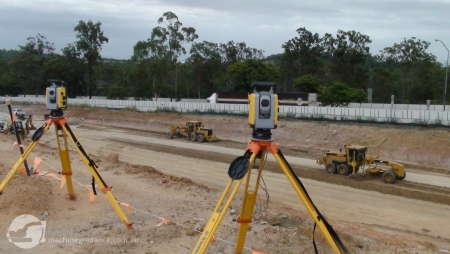
Increased Safety
Construction sites are always hives of activity. Earth is moved using heavy machinery including repeated rounds of scrapper fleets and/or road trucks. Construction programming is continuously tightening and this pressure results in multiple operations being conducted in the same work area. The work areas themselves are often difficult to access within relatively confined spaces. There is an obvious safety concern with surveyors walking around in such conditions.
As using machine guidance reduces the need for on-the-ground survey set out and construction crew string lining, there is less opportunity for workplace injuries involved with these tasks. This includes the typical manual labour injuries associated with using sledgehammers and stringlines. This also includes the particular safety concerns that are specific to construction sites including confined work spaces and large quantities of heavy vehicle movements.
In a traditional pavement trimming operation, grade checkers work behind the trim graders by running a string line between the survey stakes and using a tape measure to dip the required distance. They will use spray paint to advise the grader operator of the current level for the graders next pass. Hopefully, they will be out of the way before the grader pulls into reverse.
With machine guided construction, real-time levels are displayed to the operator inside the cab. There is no need for grade checkers, string lines or survey stakes. Clearly this scenario demonstrates a safer construction method than traditional construction methods.
Using machine guidance in bulk earthworks operations is unquestionably safer than traditional survey methods.

Increased Job Satisfaction
From a surveyor's point of view, there is also an often-overlooked advantage of using machine guidance on construction sites. As survey crews are performing less of the manual and repetitive task of pegging, they are able to move on to more satisfying tasks. With the use of machine control, bulk earthworks setout is not required and the field crews always have instant access to the required information.
Similarly, another somewhat unexpected benefit of using machine guidance is the closer working relationship between field crews and surveyors. Traditionally in the Australian construction environment, surveyors do not get involved with any earthworks planning; they are largely removed from the earthworks operation and responsible purely for setting out the intended design and then checking completed works against the design.
However, by integrating the survey systems and the construction equipment, the two groups have been forced to work closer together which has helped open up communications between crews.
Consequently, the use of machine control has contributed to a reduction in project staff turnover.
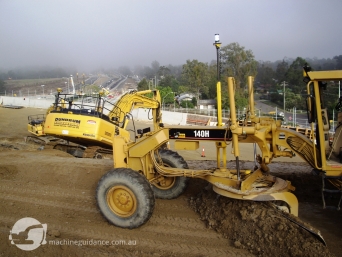
Challenges of Machine Control
This article has presented the numerous advantages of using machine guidance over more traditional survey methods. However, like any new method there are also a number of challenges to overcome.
Some of the more common challenges of machine guided construction include:
- Field reference without survey pegs.
- Operator training for new method.
- Reliance on machine control leading to the need for effective support.
- Machine control is largely limited to earthworks construction.
These challenges are highlighted in a separate article titled "Machine Guided Construction - Challenges".

Back to All Articles


